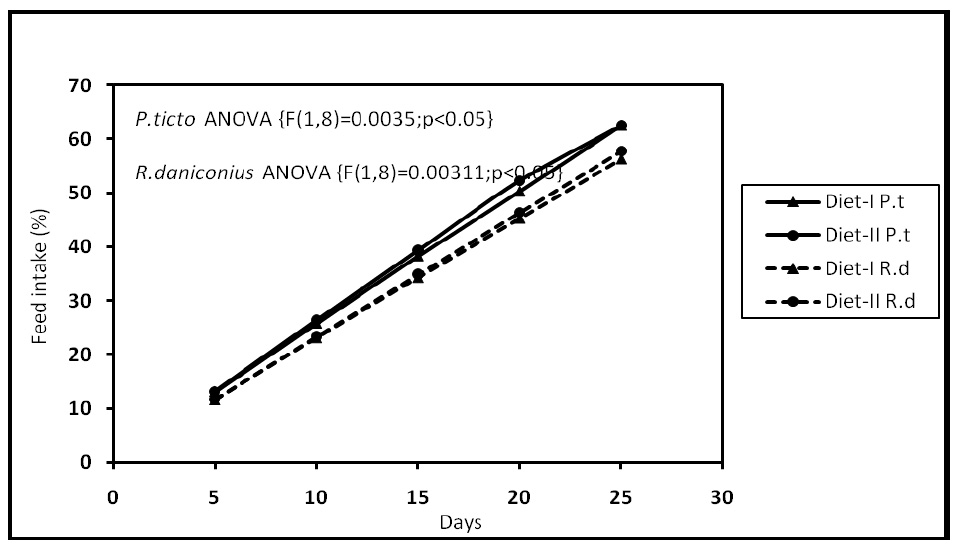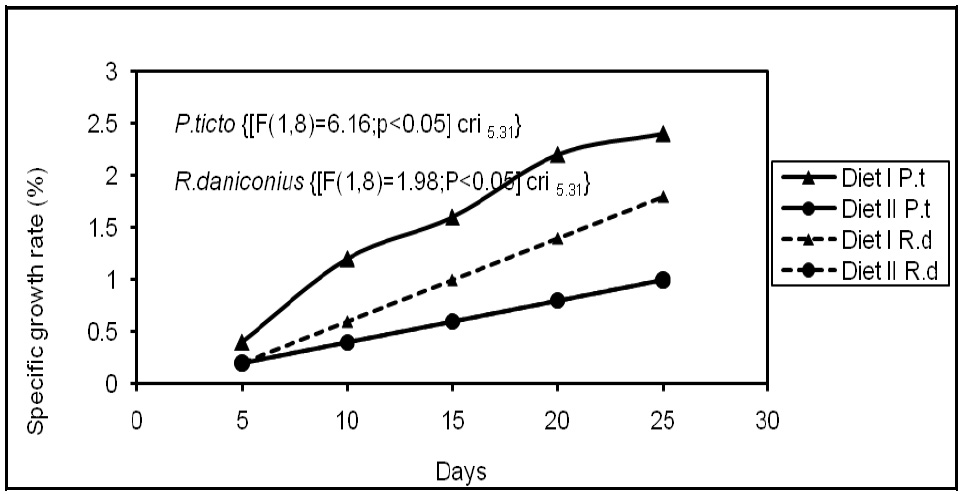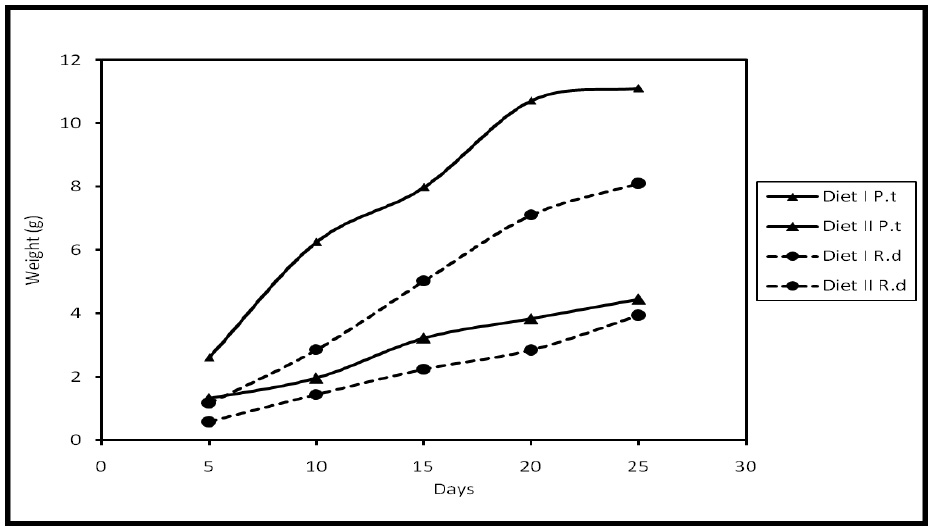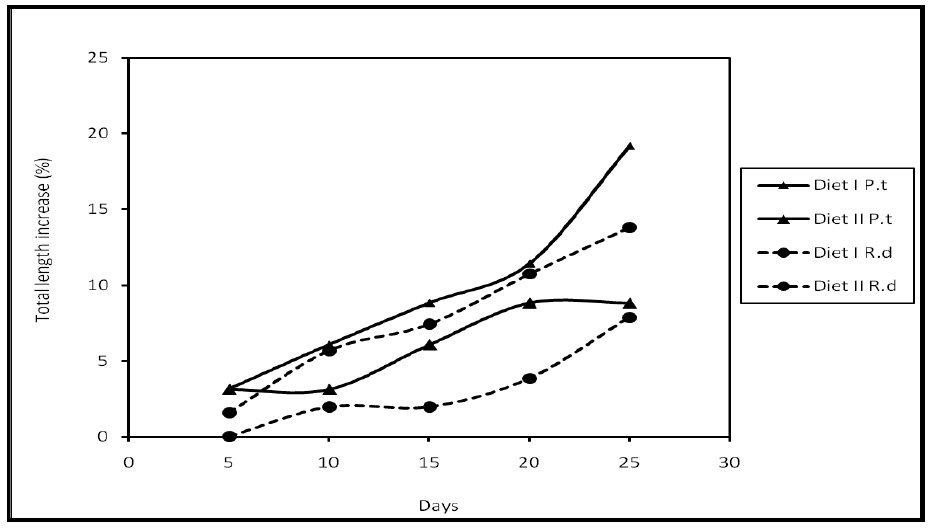Partial replacement of fishmeal by animal protein with supplement of diets in freshwater fish Rasbora daniconius (Hamilton, 1822) and Puntius ticto (Hamilton, 1822)
Department of Zoology, Dr. Babasaheb Ambedkar Marathwada University, Aurangabad-431 004. Maharashtra, India
ABSTRACT
INTRODUCTION
Fish food consists of natural and artificial (supplementary) feeds. Sometimes, natural food may not be available in sufficient quantities. During such periods, foods manufactured or grown outside fish pond can be fed at regular interval. The feed supplements may not be nutritionally complete and may not support fish growth. Natural food in the water provides essential nutrients and in the absence of natural foods, all essential nutrients must be fed to fish. Artificial feeds are well-compounded mixtures of feedstuffs which can be in the form of mash or pellets, suitable for fish feeding. Mash feeds are good for fries and pellets (0.8-1 mm) for fingerlings, juveniles (2-3 mm), adults (4-5 mm) depending on pellet sizes. The use of artificial feeds is costly, but they have advantages in that they promote faster growth of fish. Increased usage of pellet feeds in carp culture is a necessity to increase the production and fish quality. This is especially important when the human nutritional value of the carp flesh is intended to be increased (Csengeri et al., 2013).
In the diet formulation for fish, the protein finds the upper hand as the most important proximate component in the diet. The overall digestion coefficient of the diet depends on the availability of quality protein source. The incorporation of protein in the formulated diets should be in optimum ratio with the energy components present therein. The protein component should consist of all the essential amino acids (Cho and Kaushik, 1985). The energy content in the diet varies according to the size of the fish species and on the amount of carbohydrate content (Cho and Kaushik, 1990). The fatty acid content also varies linearly with it. The vitamin and mineral composition should be in conjunction with the major proximate principles present in the aqua feed.
The cost of feed represents an important proportion of aquaculture operational costs. Protein sources are the major contributors to aquaculture feed costs (Sajed et al., 2014). Fish meal is the preferred dietary protein source for many farmed fish and shrimp species because of its amino acid balance, vitamin content, palatability and unidentified growth factors (Majumdar et al., 2014). However, fluctuating supplies and significantly elevating prices during the last decade encouraged the search for fish meal alternatives from different plant and animal sources. Plant materials suffer from low digestibility, high fibre content and antinutritional factors which limit their efficient use in aquaculture feeds (Francis et al., 2001).
The objective of the present study was to investigate the effect of different feeding rates with a diet containing appropriate protein on growth performance and food utilization. Fish meal (FM) is considered the most desirable animal protein ingredient. It constitutes a nutritionally complete diet for fish and crustaceans, due to its high protein content and digestibility as well as palatability, thus serves as an excellent source of essential fatty acids and energy.
MATERIAL AND METHODS
The fish Puntius ticto (Hamilton, 1822) and Rasbora daniconus (Hamilton, 1822) were procured from Godavari River, near Kaigaon toka, Aurangabad Maharashtra, India. They were acclimated to laboratory conditions for two weeks before experimentation in glass aquarium. The fish were maintained in laboratory conditions, in natural day: light (D:L) cycle at 25±1°C. The water was changed daily. Water temperature was maintained at 25±1°C. Dissolved oxygen was between 6.54-9.83 mg/L. The P. ticto fish of average weight 15+0.1 g and length 7.36±0.19 cm and R. daniconius of average weight 17.4+0.15 g and length of 6.8+015 cm was used for the present study.
The growth experiment was conducted on acclimated fish. Both P. ticto and R. daniconius were taken and their length and weight was measured individually. After that, 10 fish of both types were placed in different aquariums such as that two aquariums for P. ticto (Group I) and two for R. daniconus (Group II) were fed with Artificial Fish Food (AFF) (Diet I) and other Animal Feed Protein (AFP) (Diet II) respectively for both fishes. Four grams of Diet I and Diet II were given to each aquarium on the first day, thereafter on every 5th day till the 25th day. On every 5th day, the length and weight of the fish were recorded.
Chemical analysis
Proximate analysis of Diet I and Diet II were carried out by drying the feed in a crucible at 100°C in a laboratory oven. After drying the diet, the diets were grinded in a mixer and again dried. The dried powder was used for the analysis. Chemical composition (moisture, fat, ash, crude fiber, proteins, carbohydrates by difference) and caloric value of Diet I and Diet II were analyzed according to the methods as described by AOCS (1992).
Protein intakes (PI)
This is the product of feed supplied and the percentage of crude protein present in the feed. This was calculated, according to the methods as described by Teugels (1984). This is given by the following formula:

Feed conversion ratio (FCR)
The FCR values were calculated by the formula:

Gross feed conversion efficiency (GFCE) (%)
This is the reciprocal of feed conversion ratio (FCR). This is given by formula:

Specific growth rate (%) per day
This was calculated by using following formula:

Growth coefficient
Growth coefficient is determined by the formula as described by Everhart et al., (1975):

where ln is the natural logarithm and wt and wo are as before (Everhart, et al., 1975).
Statistical analysis
The data were subjected to statistical analysis, using ANOVA and post-hoc Tukey’s test at significance level 0.05.
RESULTS
Proximate composition of diet ingredients
The proximate compositions for fish Diet I and Diet II were found to be fairly close except that the protein content for Diet II was 34.1% and for Diet I was 14.1%. The carbohydrate dry difference was higher for Diet I (67.5%) than for Diet II (43.9%). The values of proximate analysis are given in Table 1.
|
No. |
Parameters (%) |
Diet I
|
Diet II
|
|
1. |
Moisture |
5.1 |
6.6 |
|
2. |
Fat |
2.5 |
4.2 |
|
3. |
Ash |
4.1 |
11.1 |
|
4. |
Crude fiber |
6.7 |
0.1 |
|
5. |
Protein |
14.1 |
34.1 |
|
6. |
Carbohydrates (by difference) |
67.5 |
43.9 |
|
7. |
Caloric value (kcal/100g) |
349 |
349.8 |
Values are in percentage for 100 g of diet
Feed intake
The daily feed intake, specific growth rate and feed conversion ratio of P. ticto and R. daniconius are shown in Figure 1. Feed intake showed a similar pattern in both fish fed with Diet I and Diet II. The daily feed intake of the Group I fish showed no statistically significant difference in feed intake to Diet I and Diet II. Similarly, Group II fish also showed no statistical significant changes in feed intake.
The feed conversion ratio (FCR)
The feed conversion ratio for P. ticto and R. daniconius for Diet I and Diet II is shown in Figure 2. The study showed less FCR for Diet I compared to Diet II. However, FCR showed no statistically significant difference between the two diets in Group I fish. Similarly, FCR for Group II fish also showed no statistically significant difference.
The specific growth rate
The specific growth rate studies of P. ticto and R. daniconius to Diet I and Diet II are shown in Figure 3. The specific growth rate for P. ticto for two different diets showed a significant statistical change. In R. daniconius, however, both diets showed no statistical significant changes indicating that Diets I and II had no significant effect on R. daniconius.
Gross feed conversion efficiency (GFCE)
The gross feed conversion efficiency (GFCE) for P. ticto and R. daniconius is shown in Figure 4. The GFCE showed a statistically significant increase in P. ticto for Diet I and Diet II. However, the GFCE for R. daniconius showed no statistically significant (P<0.05) difference between Diet I and Diet II.
Growth coefficient
Body weight and total length of P. ticto and R. daniconius are shown in Figures 5 and 6, respectively. The body weight in Group I fish showed a significant increase for Diet I and Diet II. However, Group II fish showed no statistically significant increase with both diets. The total length increase to both diets showed no statistically significant difference for Group I and Group II fish, respectively.
Percentage increase in body weight and total length to diets
The percentage increase in body weight and total length for Group I and Group II fish are shown in Figures 7 and 8, respectively. The body weight in Group I showed a significant increase between Diet I and Diet II. However, Group II fish showed no statistically significant difference between both diets. The total length increase in both diets showed no statistical significant difference for Group I and Group II fish.
DISCUSSION
Studies on the growth of fish supplemented by alternative sources of feed with a view to find an alternate source of fish feed in aquaculture have been carried out by various workers over the world (Hartviksen et al., 2014; Ljubojevic et al., 2015; De Santis et al., 2015). The lesser known fish, which are not a major carp, are eaten by poor people, however, with the push in aquaculture this fish has been recognized as a valuable source of protein.
In the present study, a linear relationship of food intake was observed in P. ticto and R. daniconius with Diet I and II. The FCR was less for Diet I compared to Diet II, though, no statistical significant changes were observed. The body weight, length, FCR, specific growth, growth coefficient (weight, length), all showed an increase in both fish, but Diet I caused a higher increase compared to Diet II.
The reduced growth with Diet II could be due to an increased protein in Diet II compared to Diet I. There are reports showing that higher proteins slow growth rate which may be due to low digestibility, poor protein and amino acid utilization or some unknown factors could reduce the growth of fish (Beeker and Makkar, 1999). Saeed et al. (2005) reported a low growth rate in Labeo rohita, provided with soya bean meal to corn glutens protein. Similar observations were reported by other workers (Rajbanshi, 1989; Salim and Sheri, 1999).
Dabrowski (1977) reported that gram carp fry requires 45.6% protein. Similarly, dietary protein requirement of 40% and above have been reported by various workers, which increased weight gain and SGR (Diyaware et al., 2010; Sawhney and Gandotre, 2010).
Siddiqui et al. (1988) and AlHafed (1999) reported that decrease in feed conversion ratio is due to an increase in proteins. The present study also showed that lower protein level resulted in higher feed conversion ratio and growth level. The proteins in both diets (Diet I and Diet II) were different, Diet I contained 14.1% and Diet II contained 34.1% proteins. The study indicated that in fish P. ticto and R. daniconius high protein may not be helpful for growth. The present results are in contrast to the reports of Sawhnay and Gandotre (2010) and Diyaware et al. (2010). However, Diet II can be improved with low formulated animal protein source, which may increase FCR and facilitate better growth in this species of fish. Nutritional absorption and growth need further investigation when applying animal protein sources in the diet. The present finding is comparable to other studies, in that high protein feed in fact decrease the feed conversion ratio.
Information on feed consumption pattern is necessary to achieve an optimized feeding regime for particular fish species (Wang et al., 1998). In the present study, the daily feed consumption patterns of both fish were similar. Growth parameters of fish in this experiment compares well with previous studies of Gumus et al. (2009).
The differences within the results of the current study may be ascribed to the lower energy content. Takeuchi et al. (2002) demonstrated that energy content and thus P/E ratio, in common carp diets are determinant factors that govern feeding and growth efficiency especially during the early life stages and diets must be designed carefully to satisfy the optimum levels of these components.
Davies and Gouveia (2010) studied the response of common carp fry fed diets containing a pea seed meal (Pisum sativum); the reported SGR values relatively coincided with the results of the present study. Several researchers indicated that younger fish have higher growth rates, animal protein sources are better performed as feed ingredients than plant proteins and fish stocking density is correlated inversely with fish growth (Wilson, 2002; Jha and Barat, 2005; Dumas et al., 2010).
The enhanced growth and feeding rates in fish showed an increased feeding frequency which was shown by several workers (Ruohonen et al., 1998; Wang et al., 2007). However, there are few reports that feeding frequency did not affect size variation (Kucuk et al., 2013; Sung-Yong and Venmathi, 2015).
Improvements in weight gain and feed efficiency have been reported for juvenile channel catfish raised in aquaria and fed with diets containing menhaden fish meal levels up to 20% (Mohsen and Lovell, 1990) or 30% (Andrews and Page, 1974). Although growth and FE improvement achieved by supplementing high levels of fish meal in the diet in those studies might partially be related to the high energy or fat content contributed by fish meal, improvement by the addition of low levels of fish meal might not be explained by the slight increase in energy or fat concentrations. Mohsen and Lovell (1990) found that channel catfish fed diets containing 5-10% fish meal had significantly greater weight gain and FE than fish fed a basal diet without fish meal and that supplementing catfish oil to the basal diet did not improve fish performance.
Conclusions
It can be concluded that animal feed protein have potential in aquaculture. It is being used for major carp. Protein content of 45% and higher is shown to increase the growth of carps. However, in the present study, the growth with Diet II (34.1% protein) was less than that with Diet I (14.1% protein). The increased protein, especially, from Diet II protein induced a lesser growth compared to Diet I. However, by manipulating the Diet II protein an increase in growth can be achieved.
АCKNOWLEDGEMENTS
Authors are thankful to the Head Department of Zoology, Dr. Babasaheb Ambedkar Marathwada University, Aurangabad, Maharashtra, India. Authors are thankful to anonymous reviewers for their critical evaluation and suggestions.

 JOURNAL TOOLS
JOURNAL TOOLS










 INSTITUTE
INSTITUTE